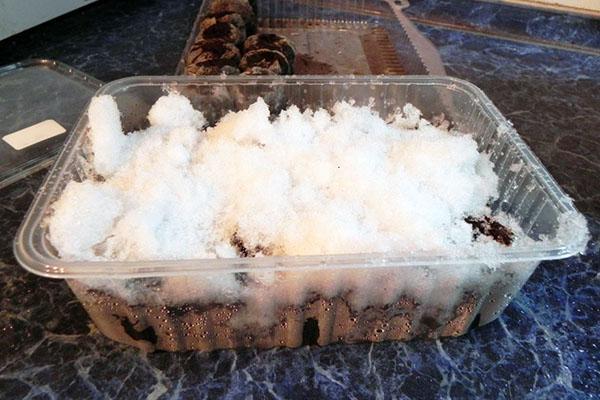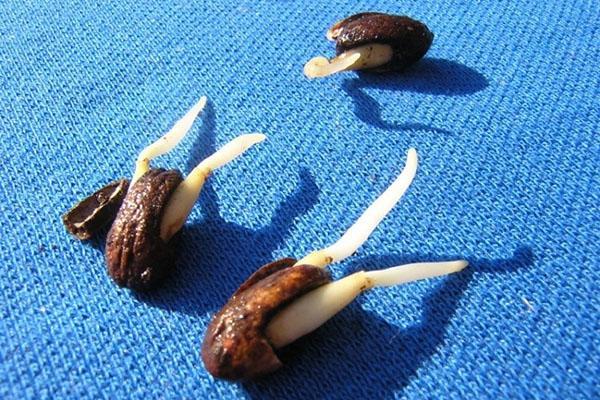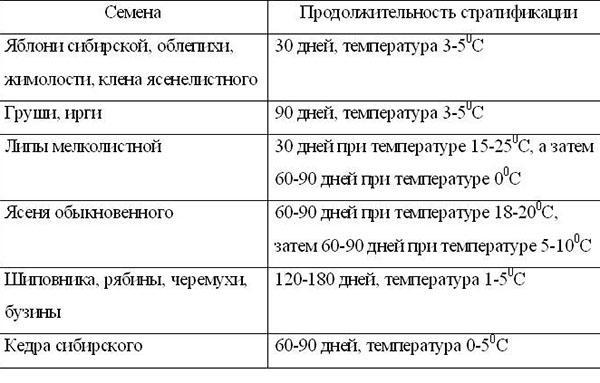How is seed stratification done at home
 Under natural conditions, each plant goes through certain life cycles from the formation of shoots in the spring to the maturation of seeds in the fall. One of the life stages of a seed in winter is preparation for germination or, in other words, seed stratification.
Under natural conditions, each plant goes through certain life cycles from the formation of shoots in the spring to the maturation of seeds in the fall. One of the life stages of a seed in winter is preparation for germination or, in other words, seed stratification.
The concept and principles of stratification

The main factors required for seed germination are:
- a certain temperature regime;
- a sufficient amount of moisture;
- oxygen access.
If the prepared seeds of fruit, vegetable or flower crops are placed in ideal conditions, then the softening of the protective crust and saturation of the grain with the ingredients necessary for growth will begin.
So, seed stratification is a process that occurs under the influence of optimal temperature and humidity, the result of which is the natural awakening of the seed and its transition from the dormant phase to the growth phase.
What seeds require stratification? Seeds that germinate poorly or slowly in natural conditions are subjected to additional processing before planting.
These include seeds:
- fruit trees (apple, pear, mountain ash and so on);
- berry bushes (rose hips, honeysuckle);
- forest trees (cedar, maple, ash);
- conifers (fir, spruce)
- perennial flowers (clematis, peony, lavender);
- some vegetable crops (peppers, eggplants, tomatoes, carrot).
How much to stratify seeds? The timing of pre-sowing treatment of plants can vary from 1 - 2 days to 6 - 8 months. You can find out the period of stratification of a particular type of crop on the seed package or in specialized reference books.
Varieties of stratification
Currently, there are the following types of stratification.
Depending on the method of seed preparation:
- cold stratification (treatment of seeds with low temperatures);

- warm or hot stratification (preparation of seeds under high temperature conditions);

- combined processing (the use of cold and warm methods in a certain order);
- stepwise preparation of seeds for germination (use of treatment with low and high temperatures several times);
Depending on the timing:
- autumn (carried out if necessary, long-term preparation of seeds, for example, fruit and conifers);
- winter (used when it is necessary to use a combined preparation method for plants such as iris, clematis, lavender, as well as before planting indoor flowers of various types);
- spring (used for vegetable crops and unpretentious flowers, for example, when breeding primroses, aquilegia or delphinium).
How is seed stratification carried out
To stratify seeds you need:
- seed preparation;
- soil preparation;
- stratification.
The process of preparing seeds for stratification
Before carrying out the stratification process, seeds require some preparation, which takes place in several stages:
- At the initial stage, it is necessary to disinfect the seeds by treatment with a weak manganese solution (no more than 0.5%).To completely get rid of pests, 30 minutes of the procedure is enough.

- Next, the seeds are washed and cleaned. For cleaning, use only soft material that will not damage the protective shell.

- Seed soaking. Depending on the type of stratification chosen, soaking is carried out in cold (5 ° C - 7 ° C) or warm (15 ° C - 20 ° C) water, which contributes to saturation of the seed with the required amount of moisture. Soaking time varies with seed size. It is believed that it is necessary to stop moisture saturation after swelling of the seed.

- Drying. It is impossible to start stratification until the plant seeds have dried completely, as this can cause decay and death.

Soil preparation process
To carry out the stratification process, the following are optimal:
- peat;
- sand;
- a mixture of peat and sand in a 1: 1 ratio;
- vermiculite;
- sphagnum moss.
For the stratification of seeds, it is necessary that the amount of the selected soil is 3 times greater than the number of seeds undergoing pre-sowing treatment.
To disinfect the prepared soil, it is processed with high temperature by placing a container with soil:
- Into an oven preheated to 120 ° C. Processing time is 60 minutes.

- Into the microwave oven at maximum power. In this situation, 10 minutes of processing is sufficient.
Cold stratification
 For the treatment of seeds of perennial crops (for example, honeysuckle, strawberries, sea buckthorn) growing in areas with a temperate climate, cold stratification is used.
For the treatment of seeds of perennial crops (for example, honeysuckle, strawberries, sea buckthorn) growing in areas with a temperate climate, cold stratification is used.
The main conditions for processing this type are:
- compliance with the temperature regime within 0 ° С - + 4 ° С;
- provision of humidity at the level of 65% - 75%.
At home, cold stratification of seeds can be carried out:
- by placing containers (packages) with seeds and soil in a refrigerator (basement or other room with a given temperature);
- by burying the container with seeds in the ground.
If a short stratification of seeds is required (1 - 3 hours), then the container with a mixture of seeds and soil can be covered with a layer of snow and placed in a cold place.
The timing of cold seed stratification depends on the plant variety. However, during the entire period of processing, it is recommended to carry out periodic inspections (1 time in 10 - 15 days) of containers for the formation of rot and the need for additional soil moisture.
Warm stratification
 Vegetable crops such as peppers, cucumbers, tomatoes and eggplants are hot stratified.
Vegetable crops such as peppers, cucumbers, tomatoes and eggplants are hot stratified.
The main conditions for heat treatment of seeds are:
- ensuring the temperature at the level of 18 ° С - 22 ° С;
- moisture supply. The moisture level in the seed container must exceed 70%.
Warm stratification can be done either by placing seeds in prepared soil or using a cloth.
Combined and stepwise stratification
 The average time for seed treatment in high temperature conditions is 5 - 7 days. How to speed up stratification? The process of preparing seeds for sowing will be faster if combined or step stratification is applied. For this, seeds and soil prepared according to the method indicated above for a certain time (in accordance with the recommendations of specialists) are first placed in conditions of an increased temperature regime, and then swept into the cold.
The average time for seed treatment in high temperature conditions is 5 - 7 days. How to speed up stratification? The process of preparing seeds for sowing will be faster if combined or step stratification is applied. For this, seeds and soil prepared according to the method indicated above for a certain time (in accordance with the recommendations of specialists) are first placed in conditions of an increased temperature regime, and then swept into the cold.
With a one-time change of the regime, a combined stratification is obtained, and with several cycles of changing the temperature background several times, a stepwise stratification.
For the correct implementation of the combined or stepwise stratification, the container with seeds must be marked, indicating not only the name of the plant, but also the date of completion of a particular stage.
Thus, the process of seed stratification on their own and at home can be carried out not only by professionals, but also by novice gardeners. The main thing is to follow all the rules and recommendations.